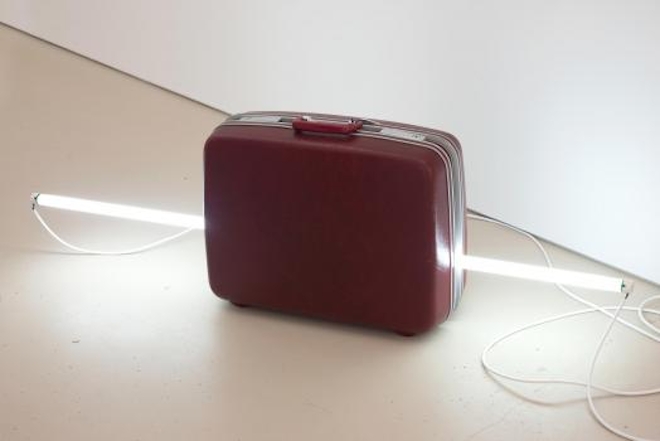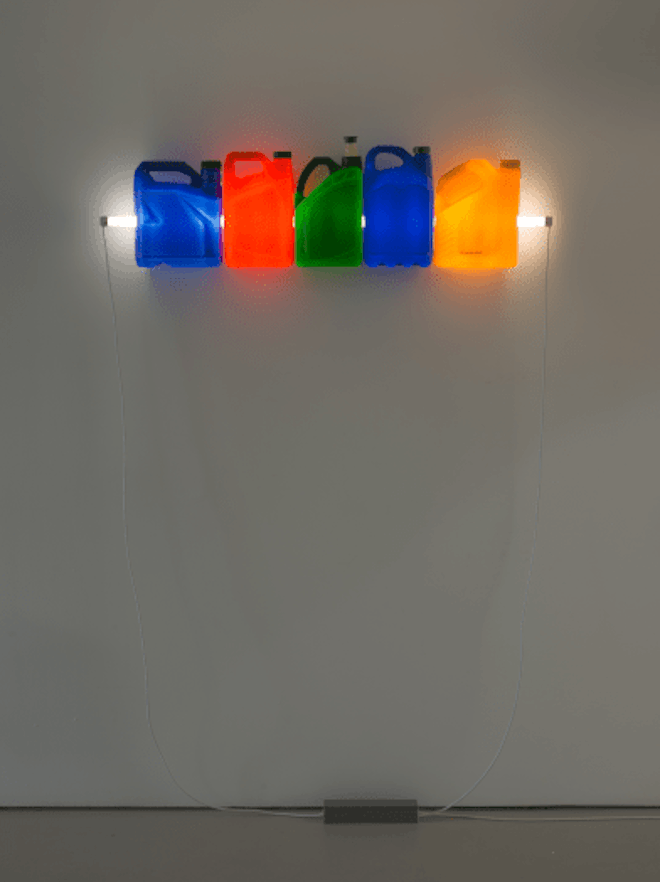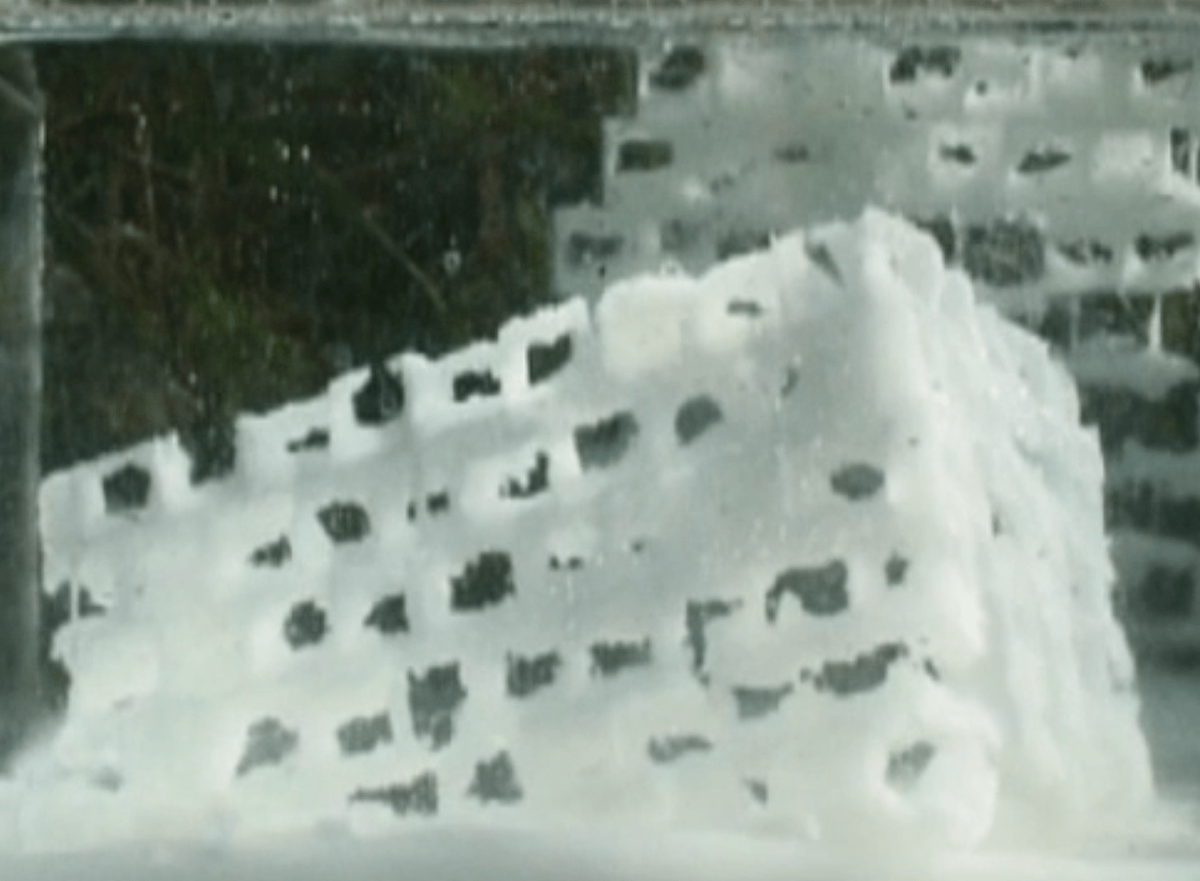We typically think of duration as something we endure. It is a period of time in which something occurs. Or a period of time in which we undertake something. It sounds physical, it sounds spatial. It is a kind of arrangement of time and space. A spatio-temporal condition. At its simplest, duration is like an endurance event or even what we are going through now as a nation. So of course moving image work is going to have a particular ability to respond to such conditions. Think of how cannily performance artists were able to turn to the video to record themselves precisely because those events were bound physically to a period of time. Better yet, often recorded in real-time, these documents also bound us as viewers to the same durational event, admittedly passively as mere onlooker (which also explains that generation's ambivalence to documentation). Alternatively think of Andy Warhol’s film of the Empire State building, or more recently, Douglas Gordon’s slowed down Psycho (1993), both of these films purposefully work with the extensibility of time, a duration that is hard to endure but rewarding because of the banality it exposes, those small pleasures one can take in repetition or stasis. Clearly then we can say that the concept of duration is keenly represented in moving image work, but more importantly, it is also able to actuate a perception of duration in the viewer. Do we need to say though that this is solely the purview of moving image work alone? Might we equally say that this inducement crosses the medium barrier and informs other modes of contemporary production? What we can say now though is that moving image’s privilege as a time-based medium makes it a particularly apt way to discuss how concepts of duration highlight how this concept currently informs contemporary practices.
Let’s start with an older work of Richard Frater’s, Sweet Apparition (2008). At its most basic it is a twenty-minute video of sugar cubes dissolving in a tank of water. Already then we have that prototypical durational video, a format that is readily shared amongst artists, like for instance Steve Carr’s popping balloons, or Erica van Zon’s remake of Bas Jan Ader’s floral arrangements (a duration upon a duration). And yet, it’s significant that Frater is dissolving a sugar cube given Henri Bergson’s use of the sugar cube as an example of duration, of a period of time that coincides with our own lived time. Here is the relevant passage:
If I want to mix a glass of sugar and water, I must, willy nilly, wait until the sugar melts. This little fact is big with meaning. For here the time I have to wait is not that mathematical time which would apply equally well to the entire history of the material world… [Rather] it coincides with my impatience, that is to say, with a certain portion of my own duration, which I cannot protract or contract… It is no longer something thought, it is something lived. It is no longer a relation, it is an absolute.(1)
What Bergson also highlights here is that the sugar cube isn’t just a static object, but that it always reserves something of itself for itself. This is more obvious precisely because we must wait for the cube to dissolve and in doing so reveal that all objects undertake activity in an asymmetrical relation with their observers. Moreover when we wait for the sugar cube to dissolve, we not only experience our own mode of observation but register something of the sugar cubes’ lived rhythm. This is how Giles Deleuze phrases it:
Take a lump of sugar: it has a spatial configuration. But if we approach it from that angle, all we will ever grasp are differences in degree between that sugar and any other thing. But it also has a duration, a rhythm of duration, a way of being in time that is at least partially revealed in the process of its dissolving… [Indeed] the impatience of waiting serves to reveal other durations that beat to other rhythms that differ from mine.(2)
All of which we should remember, as Bergson insists, happens not just in the material time of history, but in the real time of our own lived lives both as observer and object. In Bergson’s terminology this is the absolute function of the sugar cube, it is what grants this encounter a durational quality. What we can say then is that duration is a not just a spatial arrangement of time, but it is also a psychological experience, one closely associated with change. To borrow Deleuze again, duration usually signals a “becoming that endures, a change that is substance itself.”(3)
Sweet Apparition (2008) Richard Frater
Clearly then, Frater’s choice of the sugar cube is not an innocent piece of formalism. Yes we might trumpet its monochromatic tones, its subtle change of structure as a piece of devolution, whose ghostly remnant embraces the iconographic latency of contemporary arts most morbid of terms, entropy. Yes it is a count cycle, a system under duress, but we can account for this extensity without just repeating ourselves. And yet this is of course an instructive parallel, the work is ghostly, it does evoke a monochromatic formalism, it is a structure that undergoes a negative change, a reversal that cannot be returned, but, could we not read these symptoms differently. In fact if we heed Bergson’s example do we not suddenly appreciate the changing condition of the sugar cubes, not just as a mesmerising formal arrangement but as that perceptible duration, that rhythm so different to our own! This openness is of course the strength of Frater’s work, and it manipulates the viewer, even those that just casually glance at the piece rather than view the entire twenty minutes. What we can say is that the cube does dissolve in real time, a real time, that whilst relayed is actually, just as Bergson experienced, characterised by waiting, frustratingly so. Which explains the title of Frater’s Sweet Apparition not only as that moment that is fleeting, that sweet melody whose refrain enthrals us, but as a literal object, the sugar itself, that sweetness which in dissolving takes on another form, another duration that is different in kind from what we might initially expect.
Frater’s Sweet Apparition condenses two kinds of durations. Both the duration of the sugar cube melting and the perceptive duration of the viewer. What we might cruelly call the viewer’s tenure of endurance. We can see then that this duration is a potent filmic device capable of inducing certain conditions in its audience. Take for instance the repetitious refrain of Baloji’s Peau de Chagrin/Bleu de Nuit (Heartbreak/Night Bruise) (2018) which was recently shown at City Gallery Wellington. Does that refrain, which first just seems like a music video, not become a kind of duration that holds the montage together, it's repeating verse chorus structure operating as a kind of puncture that manipulates the duration of the film to expose other kinds of rhythm, other modes of life. Little surprise then that this video would be shown under the rubric of encounters, pairing it with Michael Parekōwhai’s tino rangatiratanga astronaut as a wider postcolonial plug for the ongoing resurgence of divergent histories that privilege indigenous engagement as a polyglot amalgamation of cultures happening on their own terms. Clearly then, to return to our main theme, the durational offers itself as a very specific tool of inducement, particularly in moving image work, but I wonder if we might not learn how to read this technique or mode in sculpture, particularly in regards to the testimonial object as mentioned in my last column. For surely the pairing of Parekowhai and Baloji highlights the durational aspects of Parekowhai’s sculpture which cloaks the neocolonial aspirations of NASA as a suture upon which to cast a different temporal cadence, one not entirely different to that previously mined by Robert Sullivan’s poem sequence Star Waka (1999).(4)
In fact if we heed Bergson’s example do we not suddenly appreciate the changing condition of the sugar cubes, not just as a mesmerising formal arrangement but as that perceptible duration, that rhythm so different to our own!
But let’s return to an example from my testimonial column, the recent showing of Fiona Connor’s brass replicas of ordinary gallery equipment, brooms, chairs.(5) Did we not say that this testimonial tableaux, a chair pitched against the wall, the discarded coffee cup, the ear buds, the broom all pointed to the occluded and yet supportive apparatus of any gallery’s daily function which are normally kept from view. But could we not also say that they equally pointed to a menial duration, even a kind of down time that surely the positioning of the chair, the ear plugs, and the coffee cup all attest to. After all, the ear plugs are casually placed onto the chair as though the technician had momentarily suspended their labour. It’s this inactivity (or even the implied possibility of an activity to be taken up) that signals a clear difference between Connor’s replication and other similar gallery duplications, notably Peter Fischli and David Weiss’s Raum unter der Treppe (1993) their replica utility room at Frankfurt’s MMK. There that room looks dormant, it is a replication that is jovial about its banal reproduction of the quotidian, whereas with Connor we get a mausoleum treatment, the works are cast in solemn bronze not rubber (as with Fischli and Weiss). By contrast there is a levity to Connor’s work that can’t be passed up so quickly. It’s not just that work has stopped but that someone is paying direct attention to it. These then are implacable objects, like Parekowhai’s inscrutable astronaut, and yet they too are dense with a lived duration that the viewer cannot help but become acclimatised to.
Clearly then moving image work doesn’t have a monopoly on the duration as a unique technique within cultural production but I wonder if we can go a little further than just saying objects come embedded with a cultural history that can be marshalled as a specific periods, particularly as these might be marked by subjectivities that undergo change. To achieve this I suggest we look at the work of Bill Culbert, in particular his works that combine the fluorescent light bulb with everyday objects, plastic bottles, containers, doors, chairs, and suitcases. Take for instance Moa Point, a fluorescent tube piercing a suitcase that sits casually upon the floor. Doesn’t the whole thing look portable, like you could swing it about? But let’s be particular, let’s assume "Moa Point" is a reference to Wellington’s waste water facility, or at least a geographical locution to the flotsam of recycling that this battered suitcase reminds us of. Can we not also say that Culbert’s suitcase carries a patina, a residue of activity, a duration of lived time. Isn’t this even more likely precisely because the suitcase is so nostalgic (pre-castor wheels, pre-carry-on)? And what of that fluorescent tube? Can’t we call that an arbitrator. Doesn’t it serve the same process as the bar in music does? That it places them into a kind of progression. Isn’t Culbert able to thread so many disparate objects (suitcases, plastic bottles, doors, desks, chairs, and tables) onto these bulbs precisely because they are a standardised unit? Is this not like Frank Stella’s enamel paint, the tin can he simply dips his brush into? Could we not refer to Culbert’s fluorescent bulb as a similar kind of implementing device that transforms the artist into an executive agent, whose momentary act of bricolage inaugurates a whole new duration for this hybrid object, that Culbert is somehow secondary to?

Moa Point (2018) Bill Culbert. Suitcase, fluorescent tube, 450 x 1550 x 170mm. Courtesy of the Culbert Trust and Mossman, Wellington
Let’s look at a popular series from Culbert’s practice, those in which he strings together an arrangement of plastic bottles pierced by the neon tube into a linear sequence. Take for instance Blue, Red, Green, Blue, Yellow (2014). This isn’t just decorative upcycling, but a kind of reductive use of surplus, something empathically signalled by the prescriptive title. This is a prescribed subduing of the object, so that they are not just threaded onto the light bulb, the standardised metre, but agglomerated as a metonymic repetition that refers so simply to its own act of acquisition. Like Connor’s mausoleum treatment of the technician’s tools we can think of these illuminated objects as enjoying an afterlife that points to a particular duration or past that is keenly felt by the viewer. Look for instance at the language of Yves Abrioux who suggests that “Culbert’s cheap or cast-off objects” are invested with “the pulse” of a “luminescent liquidity [that] refigures them in sensation”.(6) Which is to say that they are vividly present, that they are illuminated objects whose sensation is a kind of medium in itself, echoing what Deleuze characterises in the work of Francis Bacon as being that “objective indiscernibility or indeterminability between two forms.”(7) That is sensation, as it is in Abrioux’s reading of Culbert’s illuminated objects, denotes an entity changing from one form to another. More clearly, sensation captures momentarily that indeterminate passage of a duration that is occurring.

Blue, Red, Green, Blue, Yellow (2014) Bill Culbert. Plastic bottles, fluorescent tube, fittings, 350 x 1250 x 140mm. Courtesy of the Culbert Trust and Mossman, Wellington
Clearly then we might speak of Culbert’s work as a different kind of duration. In fact, Culbert’s act of bricolage doesn’t just bring new agglomerations into being, but it also suspends objects in a preternatural stasis, what we might call a duration without end. This is why Abrioux refers to these works as a marked form of sensation, but it also explains the relative obscurity of Culbert’s earlier works that are akin to this series in which the neon tube rather than piercing the object provides instead the handle for various farmyard tools. There, the literal object no longer suspends the device but rather makes it analogous, which is to say gives it a utilitarian function. None of this occurs when the neon-tube becomes an arbitrator, becomes a bar that pierces through an object. Of course this insertion doesn’t just suspend the object but courses light through it allowing the object to take on its own duration, something we can only read as a form of sensation.
Culbert’s use of the neon tube is a way of injecting fluidity into objects that have been previously discarded or overlooked. Effectively we might say that Culbert inserts an endless duration into the quotidian, further exacerbating that already expansive time-scale we throw so casually around as the everyday. This is a complication upon the earlier definitions of duration with which we began in which a duration is a clearly defined period of time, not a protracted or expansive scale. However, it may pay to heed Jane Bennett’s warning that Bergson models perception as a subtractive process, so that his notion of duration tends to lean towards instrumentality and bias.(8) And yet it also worth mentioning that Bergson’s process always leaves something behind, something we might, following Graham Harman, refer to as the surplus of reality,(9) a distinction we should say is not so simply the backdrop upon which life annunciates itself, but rather an indifferent schema where durations of every scale are occurring. This is of course something that the indeterminate sensations of Culbert’s light works are similarly replicating, drawing us into their own arbitrarily drawn realities much in the same way that Frater’s Sweet Apparition does as well.
